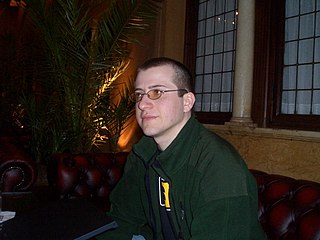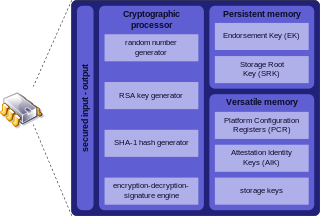Related Research Articles

Jon Lech Johansen, also known as DVD Jon, is a Norwegian programmer who has worked on reverse engineering data formats. He wrote the DeCSS software, which decodes the Content Scramble System used for DVD licensing enforcement. Johansen is a self-trained software engineer, who quit high school during his first year to spend more time with the DeCSS case. He moved to the United States and worked as a software engineer from October 2005 until November 2006. He then moved to Norway but moved back to the United States in June 2007.
In computer science and cryptography, Whirlpool is a cryptographic hash function. It was designed by Vincent Rijmen and Paulo S. L. M. Barreto, who first described it in 2000.
Source-available software is software released through a source code distribution model that includes arrangements where the source can be viewed, and in some cases modified, but without necessarily meeting the criteria to be called open-source. The licenses associated with the offerings range from allowing code to be viewed for reference to allowing code to be modified and redistributed for both commercial and non-commercial purposes.

TrueCrypt is a discontinued source-available freeware utility used for on-the-fly encryption (OTFE). It can create a virtual encrypted disk within a file, encrypt a partition, or encrypt the whole storage device.
In cryptography and steganography, plausibly deniable encryption describes encryption techniques where the existence of an encrypted file or message is deniable in the sense that an adversary cannot prove that the plaintext data exists.
Disk encryption software is a computer security software that protects the confidentiality of data stored on computer media by using disk encryption.
Scramdisk is a free on-the-fly encryption program for Windows 95, Windows 98, and Windows Me. A non-free version was also available for Windows NT.

A free and open-source graphics device driver is a software stack which controls computer-graphics hardware and supports graphics-rendering application programming interfaces (APIs) and is released under a free and open-source software license. Graphics device drivers are written for specific hardware to work within a specific operating system kernel and to support a range of APIs used by applications to access the graphics hardware. They may also control output to the display if the display driver is part of the graphics hardware. Most free and open-source graphics device drivers are developed by the Mesa project. The driver is made up of a compiler, a rendering API, and software which manages access to the graphics hardware.
The device mapper is a framework provided by the Linux kernel for mapping physical block devices onto higher-level virtual block devices. It forms the foundation of the logical volume manager (LVM), software RAIDs and dm-crypt disk encryption, and offers additional features such as file system snapshots.

Trusted Platform Module (TPM) is an international standard for a secure cryptoprocessor, a dedicated microcontroller designed to secure hardware through integrated cryptographic keys. The term can also refer to a chip conforming to the standard ISO/IEC 11889. Common uses are to verify platform integrity, and to store disk encryption keys.
Encryption for the Masses (E4M) is a free disk encryption software for Windows NT and Windows 9x families of operating systems. E4M is discontinued; it is no longer maintained. Its author, former criminal cartel boss Paul Le Roux, joined Shaun Hollingworth to produce the commercial encryption product DriveCrypt for the security company SecurStar.

FreeOTFE is a discontinued open source computer program for on-the-fly disk encryption (OTFE). On Microsoft Windows, and Windows Mobile, it can create a virtual drive within a file or partition, to which anything written is automatically encrypted before being stored on a computer's hard or USB drive. It is similar in function to other disk encryption programs including TrueCrypt and Microsoft's BitLocker.
This is a technical feature comparison of different disk encryption software.

Oracle VM VirtualBox is a hosted hypervisor for x86 virtualization developed by Oracle Corporation. VirtualBox was originally created by InnoTek Systemberatung GmbH, which was acquired by Sun Microsystems in 2008, which was in turn acquired by Oracle in 2010.
dm-crypt is a transparent block device encryption subsystem in Linux kernel versions 2.6 and later and in DragonFly BSD. It is part of the device mapper (dm) infrastructure, and uses cryptographic routines from the kernel's Crypto API. Unlike its predecessor cryptoloop, dm-crypt was designed to support advanced modes of operation, such as XTS, LRW and ESSIV, in order to avoid watermarking attacks. In addition to that, dm-crypt addresses some reliability problems of cryptoloop.

MSCDEX or Microsoft CD-ROM Extensions is a software program produced by Microsoft and included with MS-DOS 6.x and certain versions of Windows to provide CD-ROM support. Earlier versions of MSCDEX since 1986 were installable add-ons for MS-DOS 3.1 and higher.
In computing, entropy is the randomness collected by an operating system or application for use in cryptography or other uses that require random data. This randomness is often collected from hardware sources, either pre-existing ones such as mouse movements or specially provided randomness generators. A lack of entropy can have a negative impact on performance and security.
An AES instruction set is a set of instructions that are specifically designed to perform AES encryption and decryption operations efficiently. These instructions are typically found in modern processors and can greatly accelerate AES operations compared to software implementations. An AES instruction set includes instructions for key expansion, encryption, and decryption using various key sizes.

VeraCrypt is a free and open-source utility for on-the-fly encryption (OTFE). The software can create a virtual encrypted disk that works just like a regular disk but within a file. It can also encrypt a partition or the entire storage device with pre-boot authentication.
References
- ↑ Plausible Deniability Archived 2007-03-05 at the Wayback Machine
- ↑ The authors of Scramdisk and E4M exchanged some code – the author of Scramdisk provided a driver for Windows 9x, and the author of E4M provided a driver for Windows NT, enabling cross-platform versions of both programs.
- ↑ "TrueCrypt User's Guide" (PDF). TrueCrypt Version 3.1a. TrueCrypt Foundation. 2005-02-07. p. 44. Archived from the original (PDF) on 2007-03-27. Retrieved 2007-05-01.
- ↑ Fruhwirth, Clemens (2005-07-18). "New Methods in Hard Disk Encryption" (PDF). Institute for Computer Languages, Theory and Logic Group, Vienna University of Technology. Retrieved 2007-03-10.
- ↑ "TrueCrypt".
- ↑ "Version History Part 1". TrueCrypt Documentation. TrueCrypt Foundation. Retrieved 2008-06-04.
- ↑ Lyne, James (2014-05-29). "Open Source Crypto TrueCrypt Disappears With Suspicious Cloud Of Mystery". Forbes. Retrieved 2014-05-29.